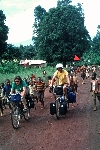|
Cameroon / Cameroun: Country of Contrast |
||
| Dispatch 3 - Bamenda | ||
|
Mbouda‑Bamenda (56km, 35 mi) Homesteads dot the rollercoaster
hillsides, the soil is very fertile. |
||
|
In Santa, jet lag, culture shock or fatigue from having not cycled enough recently (or all three things) were catching up with members of the group. While we were looking for a car that might take them to Bamenda we met Daniel who interestingly for a Cameroonian thought it would be better for everyone to ride. His pitch was, "its just another mile of up hill and then it was downhill to Bamenda." After nineteen mile of ups and downs, with more ups than downs, the "downhill to Bamenda" was music to our ears and just the kind of encouraging message a couple people needed to keep going. The is always the chance that motorist don't see the road like bicyclist, but worse case scenario was catching a lift from the side of the road. The last mile of climb turned out to be closer to three miles but none of it was too steep and there was the promise of a long downhill. When downhill came it lasted for ten miles. The descent is dream come true. Memories of fatigue mostly vanished and everyone was so glad that they were on bikes. No one criticized Daniel for being off about the last mile of hill, but rather praised him for encouraging them to stick with it and do it on the bicycle.
Along the way we continued our pursuit of identifying local languages.
When asking local what language was spoken in the village, the initial answer
was usually, "English" or "French". At which point we had to explain that we
were in interested in the indigenous language. Often they seemed so
surprised at the question that we had to repeating our selves a couple time. Out of Mbouda the next
language seems to be Ngombale, which was spoken around Babajou (also a Bamileke
language). Ten mile down the road is the bigger town of Santa. A man
we spoke to there confirmed that bigger towns tend to attract diversity.
Baba is a Mbam-Nkam>Nun language. Awing and Pinyin are Mbam-Nkam>Ngemba languages. Baligam may be a dialect of Mbam-Nkam>Nun Mungaka. Akum is probably the Bagangu dialect of the Ngemba language. This Mbu is an alternative name for Nagamambo of the Momo group. There is another very small and isolated Mbu language over by the Nigerian border but it is unlikely to have speakers in Santa. Baforchu, and Mbei are a bit of a mystery. Most of the language not only have a primary name but also sometimes a dozen alternations name and numerous separately named dialects. In my references Baforchu and Mbei are no-shows in all of the categories on the academic lists. When we ask how everyone communicated with each other the answer was, "English!" In Bamenda, itself, multiple languages are present, most of the Mbam-Nkam>Ngemba group (15 languages), but again English is the lingua-franca. |
Addendum: A side trip out of Bamenda is a visit to the palace of the Fon of Bafut, in Bafut. Of the palace in the area it is perhaps the most formal and aesthetic. The houses are in rows, connected by defined paths, and there are many full trees providing shade. The building with the main throne is also very impressive created by the proportions of high portico accentuated by the vertical pieces in the wall and then an equally high traditional thatched roof. There are parables and symbolism in much of the carving. The seat of the chair are held up by people. On the arm rest are men with pipes. Behind the chair is some detail on how the wall is constructed. |
|
|
||
|
"Hosted by
DreamHost - earth friendly web hosting"
|
||
|
|



























 Please
contact us
Please
contact us